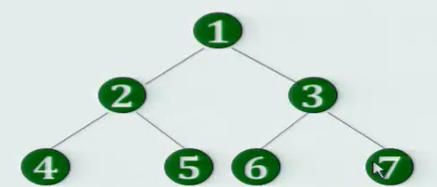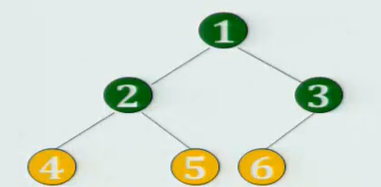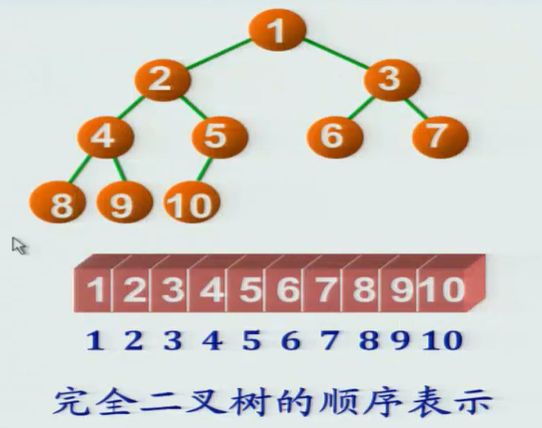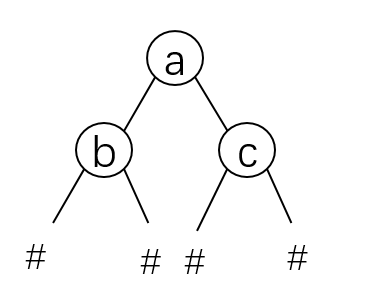二叉树
一、基本概念
二叉树的性质:
性质1:一棵非空二叉树的第i层上至多有2i-1个结点(i>1)。
性质2:深度为h的二叉树至多有2h-1个结点(h>1)。
(证明):根据性质1,二叉树中所有节点数为20+21+...+2h-1=2h-1
性质3:对于任意一棵二叉树,如果其叶子结点数为n0,度为2的结点数为n2,则n0=n2+1。
(证明):二叉树中所有结点数为:n=n0+n1+n2 。二叉树中有n-1条边,这些边由度为1和2的结点产生,即n-1=n1+2*n2,即n0+n1+n2=n1+2*n2+1,即n0=n2+1。
满二叉树:
所有叶子结点位于同一层,其它非叶子结点的度为2。若满二叉树的深度为h,则其所有结点数必为:2h-1。

完全二叉树:
扣除最大层次那层后即成为一棵满二叉树,且层次最大那层的所有结点均向左靠齐。

完全二叉树的性质:若完全二叉树有n个结点,按照从上到下,从左往右的顺序,从1开始,给每个结点编号,对于编号为i的结点有:
(1)如果i>1,则序号为i的结点的双亲结点为:i/2取整。(如2,3结点的双亲结点都为1);如果i=1,则结点i为根节点。
(2)如果2i>n,则结点i无左子女(此时结点i为叶子节点);若2i<=n,则其左子女为2i。
(3)如果2i+1>n,则结点i无右子女;若2i+1<=n,则其右子女为2i+1。
二、二叉树的存储结构
1.顺序存储
将各结点通过编号后,存入数组中。

顺序存储结构代码实现:
typedef Maxsize 100
typedef char datatype;
typedef struct{
datatype data;
int lchild,rchild;
}node;
node tree[Maxsize];
int n;
int root;
2.链式存储
每个结点包含三个域,分别用指针记录该结点的属性值,及左右子树的位置。


链式存储结构代码实现:
typedef char datatype;
typedef struct node{
datatype data;
struct node*lchild,*rchild;
}bintnode;
typedef bintnode *bintree;
三、二叉树的创建
使用createbintree()函数创建二叉树,使用链式存储结构。按照前序遍历的顺序输入二叉树各结点值,遇到空结点使使用#代替。
(例子:ab##c##)

前序遍历顺序创建二叉树代码实现:
bintree createbintree(){
char ch;
bintree t;
if((ch=getchar())=='#')
t=NULL;
else{
t=(bintree)malloc(sizeof(bintnode));
t->data=ch;
t->lchild=createbintree();
t->rchild=createbintree();
}
return t;
}
四、二叉树的遍历
1.递归遍历
递归前序遍历:
void preorder(bintree t){
if(t){
printf("%c ",t->data);
preorder(t->lchild);
preorder(t->rchild);
}
}
递归中序遍历:
void inorder(bintree t){
if(t){
inorder(t->lchild);
printf("%c ",t->data);
inorder(t->rchild);
}
}
递归后续遍历:
void postorder(bintree t){
if(t){
postorder(t->lchild);
postorder(t->rchild);
printf("%c ",t->data);
}
}
2.非递归遍历
在采用非递归实现时,需用一个栈来记录回溯点。
/* 用于遍历的栈 */
typedef struct {
bintree data[100];
int tag [100];
int top;
}sequence_stack;
/* 入栈操作 */
void push(sequence_stack *s,bintree t){
s->data[s->top]=t;
s->top++;
}
/* 出栈操作,取栈顶元素 */
bintree pop(sequence_stack *s){
if(s->top!=0){
s->top--;
return (s->data[s->top]);
}
else
return NULL;
}
非递归前序遍历:
void preorder(bintree t){
printf("前序遍历:");
sequence_stack s;
s.top=0;
while((t) || (s.top!=0)){
if(t){
printf("%c ",t->data);
push(&s,t);
t=t->lchild;
}
else{
t=pop(&s);
t=t->rchild;
}
}
}
非递归中序遍历:
void inorder(bintree t){
printf("中序遍历:");
sequence_stack s;
s.top=0;
while((t) || (s.top!=0)){
if(t){
push(&s,t);
t=t->lchild;
}
else{
t=pop(&s);
printf("%c ",t->data);
t=t->rchild;
}
}
}
φ(゜▽゜*)♪ 感谢观看,希望对你有帮助!


